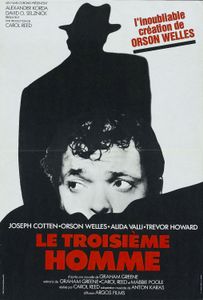 In his Criterion DVD introduction to Carol Reed’s The Third Man, director Peter Bogdanovich explains the stage concept of “Mr. Woo,” also called the “star part.” Here’s how it works: For the first hour of the play, all the characters talk, in hushed voices, about a mysterious fellow named Mr. Woo. “Just wait until Mr. Woo arrives,” they say, and, “Yes, but what will Mr. Woo think?” Mr. Woo dominates the narrative without so much as a cameo. Finally, at the end of the first act, with great dramatic flair, a small figure appears out of the shadows and—my word, it’s Mr. Woo! The curtain falls, and members of the audience remark to each other, “Isn’t the actor who plays Mr. Woo great?” It’s “your reputation precedes you” in action.
In his Criterion DVD introduction to Carol Reed’s The Third Man, director Peter Bogdanovich explains the stage concept of “Mr. Woo,” also called the “star part.” Here’s how it works: For the first hour of the play, all the characters talk, in hushed voices, about a mysterious fellow named Mr. Woo. “Just wait until Mr. Woo arrives,” they say, and, “Yes, but what will Mr. Woo think?” Mr. Woo dominates the narrative without so much as a cameo. Finally, at the end of the first act, with great dramatic flair, a small figure appears out of the shadows and—my word, it’s Mr. Woo! The curtain falls, and members of the audience remark to each other, “Isn’t the actor who plays Mr. Woo great?” It’s “your reputation precedes you” in action.
Carol Reed’s 1949 noir thriller The Third Man, among many things, boasts the finest Mr. Woo moment in all of film. For more than an hour of this 104-minute feature, the talk is all about a fellow named Harry Lime. In Vienna during the war, we learn, Lime was a racketeer of a particularly vile sort, stealing penicillin from sick children for use on the black market. He was successful both in his work and in eluding the authorities. Now it appears Lime has died, struck by a car in the street under murky circumstances. Was it a freak accident, or retribution from his former comrades for God knows what crimes? The chief of police, familiar with Lime’s history, doesn’t seem to care. “The important thing is he’s dead,” he remarks coldly.
The great scene occurs when Holly Martins (Joseph Cotton), Lime’s best friend who knew nothing of his wartime dealings, has nearly given up his investigation into what really killed him. Wandering drunkenly down the Viennese cobblestones, Martins calls out to a mysterious figure shrouded in darkness across the way. A stray cat rests between the figure’s shoes. As Martins continues his goading, suddenly a light flashes from an apartment above the street, illuminating the mystery man’s face and—why, it’s Harry Lime!
We know immediately that this man is Harry Lime. Just know it, even before Martins does. Even though we have never seen him before, haven’t been told what he looks like and, indeed, have been informed all along that he is dead, our instincts point to no other conclusion. More than anything else, however, we know who this most built-up of movie creations is because he is played by none other than Orson Welles.
Harry Lime might have been a star part on its own, but the casting of Welles, a star in his own right, is what made the character immortal. Welles knew a thing or two about colorful entrances by 1949—his first film, Citizen Kane, opened with no less than the death (and last words) of its subject—and his time with the Mercury Theatre on radio and on stage gave him a deep appreciation for the clever and the dramatic. He could be a horror to work with—as chronicled in Richard Linklater’s marvelous new film, Me and Orson Welles—but the results suggested a genius at work
In The Third Man, Welles’ contribution was to elicit sympathy—or, in any event, a fascination—for a character who was a scoundrel. Harry Lime’s entire being—his evil, his intelligence, his playfulness—is suggested in that smirk he wears when we first see him. Like Welles, Lime was a man with the confidence that he could get away with anything, who attempted anything, and who relished every moment of it.
-Dan Seliber
http://www.youtube.com/watch?v=b-MXlqC8YeE